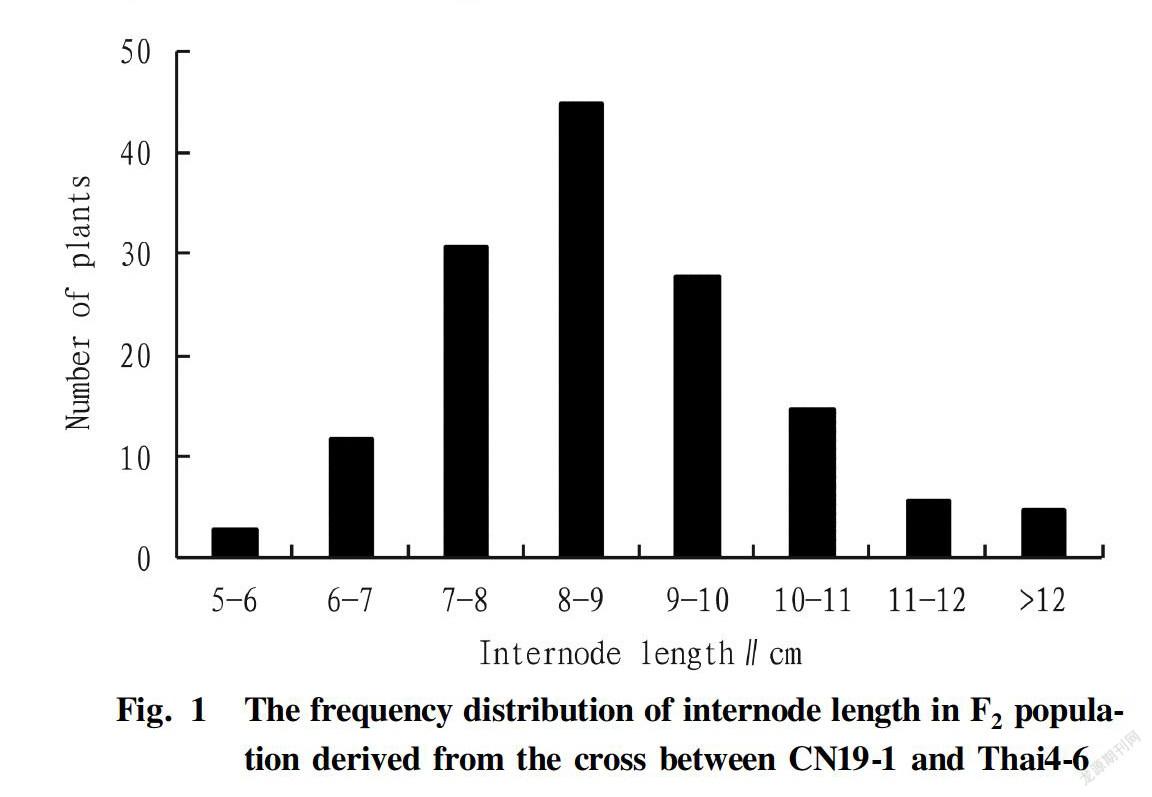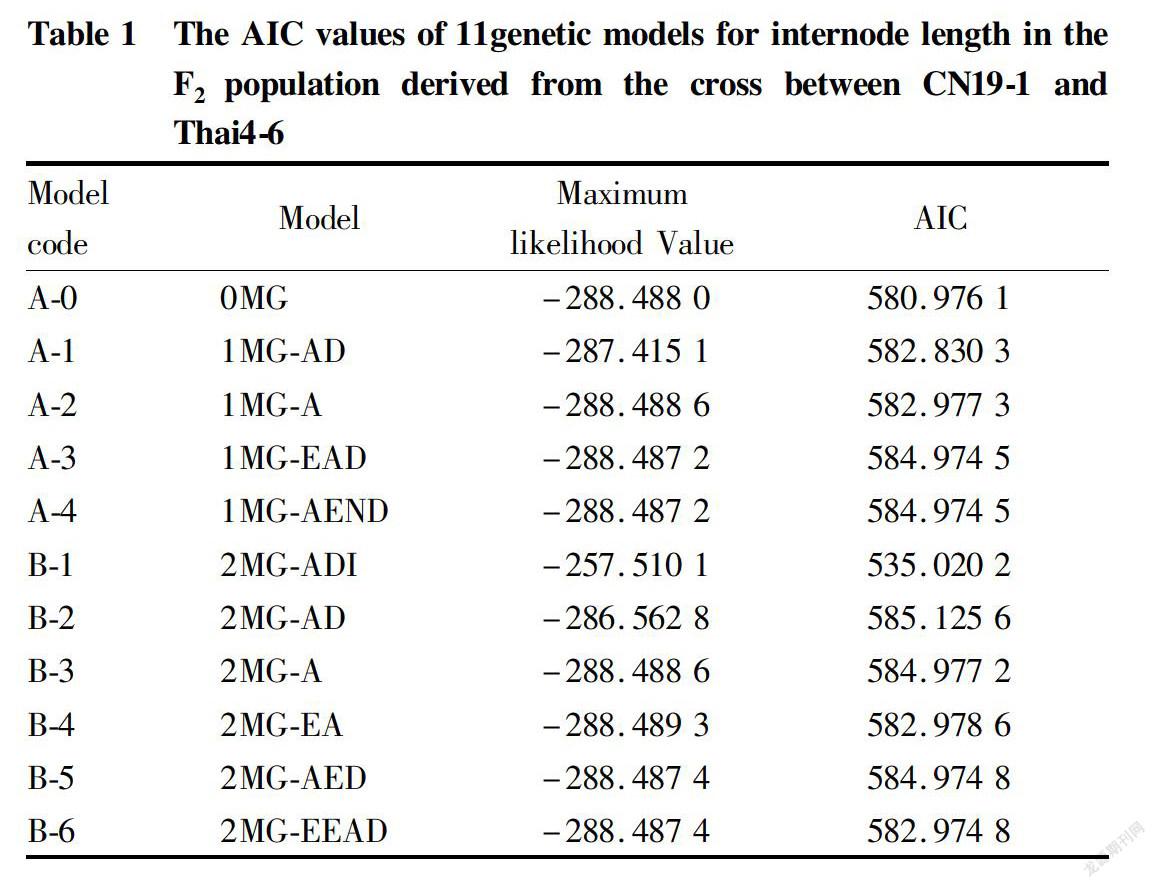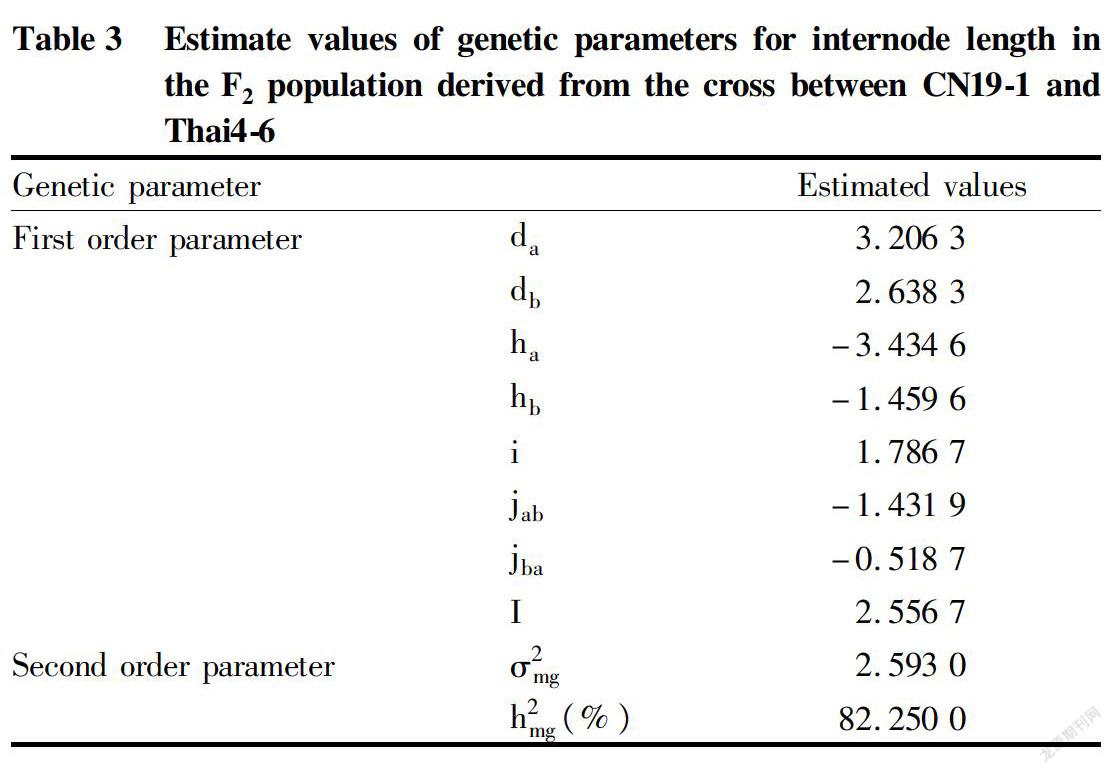The Genetic Analysis of Internode Length in Bitter Gourd
2019-09-10ZijiLIUYuNIUYanYANG
Ziji LIU Yu NIU Yan YANG




Abstract Performing the genetic mechanism research of internode length in bitter gourd has important guiding significance for making breeding strategy. A cross was made between CN191 and Thai46, and an F2 segregation population was constructed. The genetic characteristic of the internode length was analyzed through employing the major gene plus polygene mixed genetic model. The results showed that the internode length was continuous distribution in the F2 population. The optimum model for internode length genetic analysis was B1. The additive effect values of two pairs of major genes controlling the internode length were 3.206 3 and 2.638 3, respectively, which showed a positive effect. The dominant effect values were -3.434 6 and -1.459 6, respectively, which showed a negative effect. The dominant degree of major genes is -1.07 and -0.55, respectively, indicating that the first pair of major genes was over dominant and the second pair of major genes was incompletely dominant. The heritability of the major gene was 82.25%, indicating the genetic stability was high. This study could provide a theoretical reference for the breeding of bitter gourd.
Key words Bitter gourd; Genetic model; Internode length; Genetic analysis; Heritability
Received: May 16, 2019Accepted: August 5, 2019
Supported by National Natural Science Foundation of China (31601758).
Ziji LIU (1982-), male, P. R. China, Associate Researcher, devoted to research about Vegetable Genetics and Breeding.
*Corresponding author. Email: BG2018@126.com.
Viral infection and malignant tumor are two kinds of diseases that seriously threaten human health. The traditional antiviral and antineoplastic drugs are mainly reverse transcriptase or protease inhibitors, which not only have high cost and high price, but also have a single way of action. They could not completely eliminate the virus in the body, poor broadspectrum, lack of good specificity and having serious toxicity. Searching for new antiviral and antineoplastic agents from plant resources is an important development direction in the future. Because the fruit of Momordica charantia L. has special bitter taste, so it is named bitter gourd. Many researches have demonstrated that bitter gourd has significant antiviral[1-2], antibacterial[3] and antitumor activities[4-5].
In recent years, the major gene plus polygene mixed genetic model has been widely used in plant quantitative traits genetic analysis, such as cherry tomato fruit shape[6], peanut yield[7], cotton low temperature tolerance[8], and cucumber seed dormancy[9]. The genetic study of internode length in bitter gourd has been less reported. Therefore, the study on the inheritance of internode length in bitter gourd could provide reference for product development of bitter gourd. In this study, a cross had been made between CN191 and Thai46, the genetic characteristic of internode length had been analyzed by adopting the major gene plus polygene mixed genetic model based on F2 segregation population.
Materials and Methods
Tested materials
CN191 and Thai46 were the parent materials. The internode length of CN191 was about 9 cm. The internode length of Thai46 was about 7 cm.
In 2016, Thai46 and CN191 were planted in the vegetable base of Tropical Crops Genetic Resources Institute, Chinese Academy of Tropical Agricultural Sciences. F1 seeds were gained by making cross between Thai46 and CN191. F2 segregating population was obtained through F1 selfing, which will be used for internode length genetic analysis. In 2017, 20 seeds of CN191, 18 seeds of Thai46 and 145 seeds of F2 were soaked in warm water at 55 ℃ for 10 min. After soaking, these seeds were put in incubator for accelerating germination. Then the germinated seeds were planted in plug tray. After 1 week, the seedlings will be transplanted to field. Following the conventional management, the internode length of the F2 segregating population will be investigated during the full bearing period.
Data analysis
The difference of internode length between parent materials and the frequency distribution, kurtosis and skewness of F2 population were analyzed by employing SAS9.0 software. The genetic characteristics of internode length of bitter gourd were analyzed by adopting F2 segregation analysis method belonging to plant major gene plus polygene mixed genetic model. The genetic models were selected according to the minimum criterion of AIC value and the fitness test. The fitness analysis included U21, U22, U23, nW2 and Dn test. The gene effector value, variance and heritability were determined by least square method.
Results and Analysis
Phenotype data analysis
The average internode length of CN191 was 9.67 cm and the average internode length of Thai46 was 7.27 cm. The independent sample t test showed that the internode length of the parents was significantly different (P<0.05). The internode length of F2 segregation population derived from the cross between CN191 and Thai46 was grouped, and the frequency distribution was analyzed. The result showed that the internode length of the F2 segregation population was continuous distribution. The skewness value was 2.227, and the kurtosis value was 10.096, showing a positive skewness distribution. Combining above results, the internode length belonged to the quantitative trait inheritance, having extensive genetic variation (Fig. 1).
The screening of genetic model
The genetic model of internode length was screened by adopting the single segregation generation quantitative trait analysis method based on F2 population derived from the cross between CN191 and Thai46. The genetic models included 3 types. The first type was A0 model, having no major gene. The second type included A1, A2, A3 and A4 models, having 1 pair of major gene. The third type included B1, B2, B3, B4, B5 and B6 models, containing 2 pairs of major genes. The AIC values of all 11 genetic models were calculated by ECM algorithm (Table 1). The smallest AIC value was 535.020 2, belonging to B1 model. The AIC values of A0, A1 and B6 models were 580.976 1,582.830 3 and 582.974 8, which were close to the AIC values of B1 models, so they can be used as alternative models. A group of fitness test (U21, U22, U23, nW2 and Dn) of the alternative models had been performed. The results showed that B1 model had no statistic reached significant level of 0 (P<0.05), A0 model had 2 statistics reached significant level, A1 model had 1 statistic reached significant level, B6 model had 2 statistics reached significant level (Table 2). Following the criterions of the fewest significant statistics and the smallest AIC value, the B1 model was the best model for the genetic analysis of internode length in bitter gourd.
Estimate values of first and second order genetic parameters
According to the optimal genetic model B1, the first and second order genetic parameters of internode length were determined. The additive effect values of 2 pairs of major genes were 3.206 3 and 2.638 3, respectively, showing positive effects. The dominant effect values of 2 pairs of major genes were -3.434 6 and -1.459 6, respectively, showing a negative effect. The dominant degrees of the 2 pairs of major genes were -1.07 and -0.55, respectively, indicating that the first pair of major gene was over dominant and the second pair of major gene was incompletely dominant. The variance of major genes was 2.593 0 and the heritability was 82.25%. The results showed that the internode length of bitter gourd was mainly controlled by major genes, and the genetic stability was higher.
Conclusions and Discussion
From the frequency distribution of the F2 segregation population, the internode length was continuously distributed and showed the genetic characteristics of quantitative traits. Therefore, the major gene plus polygene mixed genetic model was used for identifying the best genetic model based on F2 segregation population information. This method could avoid the error caused by human classification. In addition, this method could estimate the genetic
effect of major genes, the interaction effect of major genes.
The inheritance of the internode length of bitter gourd was controlled by 2 pairs of major genes, belonging to B1 genetic model. There were additive, dominant, additive×additive, additive×dominant, dominant×additive and dominant×dominant effects among major genes. The suitable hybrid combination could promote the use of heterosis. The major gene heritability of internode length was 82.25%. In order to prevent the effect decreasing or losing of the major genes in the breeding process, this trait could be selected in the early generation of breeding.
The genetic characteristic of internode length of bitter gourd was revealed in this study. The quantitative trait loci controlling the internode length will be mapped in future research, and the closely linked markers will be identified. Molecular marker assisted selection will be used in the process of bitter gourd breeding.
References
[1] BOURINBAIAR AS, LEEHUANG S. The activity of plantderived antiretroviral proteins MAP30 and GAP31 against herpes simplex virus infection in vitro[J]. Biochem Biophys Res Commun, 1996, 219(3): 923-929.
[2] FAN JM, ZHANG Q, XU J, et al. Inhibition on hepatitis B virus in vitro of recombinant MAP30 from bitter melon[J]. Mol Biol Rep, 2009, 36(2): 381-388.
[3] CIOU SY, HSU CC, KUO YH, et al. Effect of wild bitter gourd treatment on inflammatory responses in BALB/c mice with sepsis[J]. Biomedicine, 2014, 4: 17.
[4] ZHANG CZ, FANG EF, ZHANG HT, et al. Momordica charantia lectin exhibits antitumor activity towards hepatocellular carcinoma[J]. Invest New Drugs, 2015, 33(1): 1-11.
[5] CAO D, SUN Y, WANG L, et al. Alphamomorcharin (αMMC) exerts effective antihuman breast tumor activities but has a narrow therapeutic window in vivo[J]. Fitoterapia, 2015, 100: 139-149.
[6] CHENG Y, LI HT, LU SW. Genetic analysis of fruit shape index using mixed major gene plus polygenes inheritance model in var. cerasiforme[J]. Acta Agriculturae Borealisinica, 2008, 23(6): 164-167. (in Chinese)
[7] ZHANG XY, HAN SY, TANG FS, et al. Genetic analysis of yield in peanut (Arachis hypogaea L.) using mixed model of major gene plus polygene[J]. Afr J Biotechnol, 2011, 10(37): 7126-7130.
[8] ZHANG X, LI CQ, WANG XY, et al. Genetic analysis of cryotolerance in cotton during the overwintering period using mixed model of major gene and polygene[J]. J Integr Agric, 2012, 11(4): 537-544.
[9] TANG HX, SI LT. Quantitative genetic analysis of seed dormancy in cucumber[J]. Acta Horticulturae Sinica, 2013, 40(3): 549-554. (in Chinese)
杂志排行
农业生物技术(英文版)的其它文章
- Observation on Cardiac Opening of the Inferior Vena Cava in Goat Fetuses
- Evaluation on Application and Spraying Effect of AirAssisted Sprayer in Apple Orchard with Dwarfing Rootstocks
- Problems in the Development of Traditional Chinese Medicinal Materials Planting Industry in Shiyan City and Countermeasures
- Study on Practical Mature Age of Individual Pinus thunbergii×P. densiflora
- Effects of Different Densityreducing Methods on Canopy Microenvironment, Tree Growth and Fruit Quality in Closed Apple Orchard
- Development of Whole Potato Flour Fish Noodles
